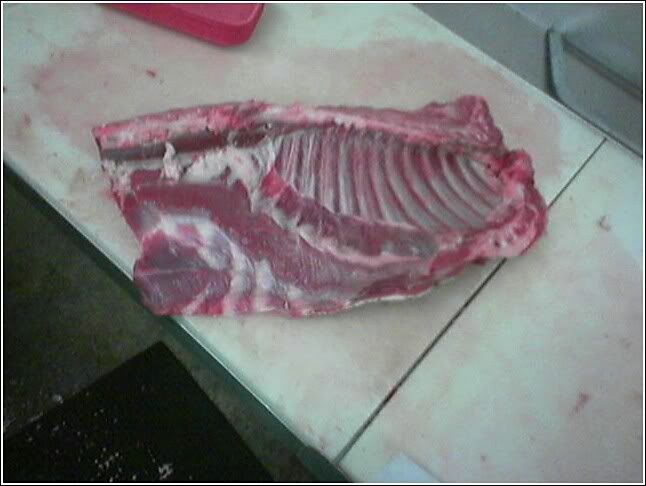Goat Slaughtering Part 2: Butchering
Sorry for the long break, as you can imagine, with the holiday season upon us, it's hard for me to find free time to post.
Anyway, so we have slaughtered the goat, known in French as Chevron and Spanish as Cabrito. First I aged it by hanging the carcass in my walk-in cooler for 6 days at ~30 degrees F. Once dry and aged, we begin the butchering.
The removal of the legs has been done, and I split the carcass into sides by sawing with a bandsaw down the length of the spine. And this is what we're left with:

click on picture to full size
The first thing I do with a side is to remove the tenderloins from the underside of the spine. You could leave them on if you want loin chops, but I prefer to cook them seperately, esp. for a smaller ruminant like goats and lambs.

click on picture to full size
Then we section it. I cut down the length of the side, breaking the ribs into half. The top will be our rack and loin, the bottom will be our spare ribs, and the chuck end will be our short ribs, or stew meat, more likely. Then we separate the top loin from the rack right between the last two ribs. The piece left over is the shoulder clod, to be used for braising or stew meat.

click on picture to full size
Now the primals are ready to be divided however you please. I boned and butterflied on leg to stuff, and kept one whole. I kept the fore shanks for braising, one shoulder clod for braising, and cubed the rest of the chuck for stew meat, which I will utilize for a Jamaican Curried Goat recipe. I kept both slabs of spare ribs whole and I will probably BBQ those. I left both top loins whole for roasting, as the chops would have been too small to cook properly, and I Frenched and kept whole the two racks for a very beautiful roast. Unfortunately, it was at this point that my camera stopped working.
Anyway, so we have slaughtered the goat, known in French as Chevron and Spanish as Cabrito. First I aged it by hanging the carcass in my walk-in cooler for 6 days at ~30 degrees F. Once dry and aged, we begin the butchering.
The removal of the legs has been done, and I split the carcass into sides by sawing with a bandsaw down the length of the spine. And this is what we're left with:

click on picture to full size
The first thing I do with a side is to remove the tenderloins from the underside of the spine. You could leave them on if you want loin chops, but I prefer to cook them seperately, esp. for a smaller ruminant like goats and lambs.

click on picture to full size
Then we section it. I cut down the length of the side, breaking the ribs into half. The top will be our rack and loin, the bottom will be our spare ribs, and the chuck end will be our short ribs, or stew meat, more likely. Then we separate the top loin from the rack right between the last two ribs. The piece left over is the shoulder clod, to be used for braising or stew meat.

click on picture to full size
Now the primals are ready to be divided however you please. I boned and butterflied on leg to stuff, and kept one whole. I kept the fore shanks for braising, one shoulder clod for braising, and cubed the rest of the chuck for stew meat, which I will utilize for a Jamaican Curried Goat recipe. I kept both slabs of spare ribs whole and I will probably BBQ those. I left both top loins whole for roasting, as the chops would have been too small to cook properly, and I Frenched and kept whole the two racks for a very beautiful roast. Unfortunately, it was at this point that my camera stopped working.
07 December, 2005 11:46My tips for cooking goat is to cook it just like you would lamb. They cook very similar. Goat fat has a much gamier taste than lamb fat, though, so the meat needs to be very well trimmed, either by your butcher your yourself if that bothers you. Wet cooking methods work best, so stews and braises are best, unless you take very special care. I'll post a recipe for Curried Goat when I make some and post pictures, as well.
» Post a Comment